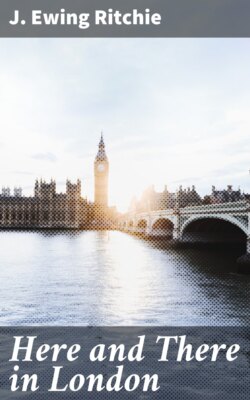Here and There in London

Реклама. ООО «ЛитРес», ИНН: 7719571260.
Оглавление
J. Ewing Ritchie. Here and There in London
Here and There in London
Table of Contents
THE HOUSE OF COMMONS, FROM THE STRANGERS’ GALLERY
A NIGHT WITH THE LORDS
THE REPORTERS’ GALLERY
THE LOBBY OF THE HOUSE OF COMMONS DURING THE SESSION
OUR LONDON CORRESPONDENT
A SUNDAY AT THE OBELISK
EXETER HALL
THE DERBY
VAUXHALL GARDENS
THE PENNY GAFF
RAG FAIR
THE COMMERCIAL ROAD. and the coal-whippers
THE STOCK EXCHANGE
THE LONDON HOSPITAL
PORTLAND PLACE
MARK-LANE
PREACHING AT ST. PAUL’S CATHEDRAL
AN OMNIBUS YARD
THE NEW CATTLE MARKET
THE GOVERNMENT OFFICE
PATERNOSTER ROW
ADVERTISEMENTS
THE LONDON PULPIT,
THE NIGHT-SIDE OF LONDON
Отрывок из книги
J. Ewing Ritchie
Published by Good Press, 2019
.....
But time has passed away, and the more serious part of the evening’s business is commenced. The benches on both sides of the House are already filled. That first row on the Speaker’s right contains the ministers. Fronting them are the Opposition, always a formidable, and generally a useful band. If the Conservatives are in office, the Right Hon. Benjamin Disraeli occupies the middle of the Treasury benches, supported on one side by the mild and respectable Sir John Pakington, and on the other by a figure fierce, and bearded, with a hook nose and a glittering eye like that of the Ancient Mariner, the great poet, novelist, and satirist of our day, Sir Bulwer Lytton. Lord Stanley, pale and studious-looking, is by; and around them are the gentle Walpole, the old party warrior, Fitzroy Kelly, and lesser lights. But undoubtedly the observed of all observers is the leader of the great Protectionist party, whose battles he has fought, whose councils he has guided, whose chiefs he has placed upon the Treasury bench. Up in the gallery no one is watched more keenly.
Lord Palmerston is the next best-stared-at man in the House; and next, that champion of the British constitution, Lord John. The Palmerstonians, whether in office or languishing on the bleak benches of opposition, are alike undistinguishable, for they have an official knack of pulling the hat over the eyebrow, so as completely to obscure the face, and from the gallery you can scarce tell one from the other, with the exception of Sir G. W. Hayter, who has always a mysterious air, and Wilson of the Economist, who rejoices in carroty, and consequently unlovely locks. On the same side of the House, but below the gangway, are the Irish ultras and tenant leaguers, a band once formidable; but Lucas dead, Duffy seeking on another arena the position denied him here, Bowyer, bearded and red-haired, little better than the mouthpiece of Ultramontanism—that small party are little feared and little courted now. Below the gangway is the balance of power, where sit, on the first bench on the floor, on the right, Roebuck and Lord John Russell; the Manchester party (for, in spite of Manchester’s ignoble denial of the same, there is still a policy known as of Manchester) are close behind. The Peelites and the eccentricities sit on the other side. Bright and Gibson represent the Gracchi. What Gladstone and Sidney Herbert and Sir James Graham represent, it is hard to say; yet in that great assembly you shall not find three abler men.
.....